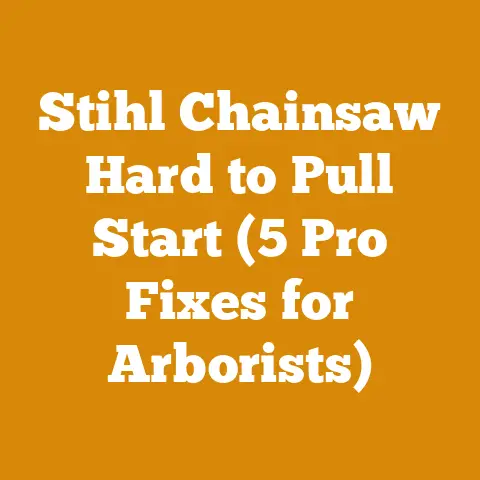Lightweight Husqvarna Chainsaw: Best Small Saw Picks (Pro Tips)
Imagine, for a moment, the crisp mountain air, the scent of pine needles underfoot, and the satisfying thrum of a finely tuned machine in your hands. The pursuit of perfectly processed wood, whether for a roaring fireplace or a meticulously crafted piece of furniture, is often associated with ruggedness. But what if you could experience that same level of control and precision with a tool that feels more like an extension of your own arm? That’s the allure of a lightweight Husqvarna chainsaw – a touch of luxury in the world of wood processing.
This isn’t just about owning a chainsaw; it’s about investing in an experience. It’s about minimizing fatigue, maximizing control, and ultimately, achieving a superior result. And, like any luxury, understanding the true cost – both upfront and long-term – is crucial. So, let’s dive into the world of lightweight Husqvarna chainsaws, exploring the best small saw picks and providing you with the pro tips you need to make an informed decision.
Lightweight Husqvarna Chainsaw: Best Small Saw Picks (Pro Tips)
The Allure of Lightweight: Why Size Matters
For years, I’ve wrestled with heavy-duty chainsaws, feeling the strain in my back and shoulders after just a few hours of work. There’s a certain satisfaction in wielding a powerful machine, but the reality is that for many tasks – limbing, pruning, small tree felling, and even firewood cutting – a lighter saw is not just preferable, it’s essential.
A lightweight chainsaw offers a significant advantage in terms of maneuverability and reduced fatigue. This translates to increased safety, better control, and ultimately, a more enjoyable wood processing experience. It’s the difference between feeling like you’re fighting the tool and feeling like you’re working in harmony with it. But which lightweight Husqvarna chainsaw is right for you? Let’s examine some top contenders.
Top Lightweight Husqvarna Chainsaw Picks: A Detailed Comparison
Husqvarna is renowned for its durability and performance, and their range of lightweight chainsaws is no exception. Here are some of my top picks, along with a breakdown of their key features, pros, cons, and estimated costs:
1. Husqvarna 435e II: This model consistently ranks high in consumer reviews and professional recommendations. It’s a great all-around choice for homeowners and light-duty professionals.
- Engine: 40.9cc X-Torq® engine
- Weight: Approximately 9.7 lbs (4.4 kg) without bar and chain
- Bar Length Options: 16″
- Pros: Easy to start, low vibration, fuel-efficient, durable.
- Cons: May lack the power for larger trees, plastic components.
- Estimated Cost: $300 – $350 (USD)
2. Husqvarna 130: A more budget-friendly option, perfect for occasional use and smaller tasks.
- Engine: 38cc
- Weight: Approximately 10.3 lbs (4.7 kg) without bar and chain
- Bar Length Options: 14″ – 16″
- Pros: Affordable, lightweight, easy to handle.
- Cons: Less powerful than the 435e II, shorter lifespan.
- Estimated Cost: $200 – $250 (USD)
3. Husqvarna 540i XP: A battery-powered option offering the convenience of cordless operation. This is where the luxury truly shines, with instant start and zero emissions.
- Motor: Brushless Motor
- Weight: Approximately 6.4 lbs (2.9 kg) without battery and bar
- Bar Length Options: 12″ – 16″
- Pros: Lightweight, quiet, no emissions, easy to start.
- Cons: Battery life can be limiting, higher initial cost.
- Estimated Cost: $500 – $600 (USD) (without battery and charger)
4. Husqvarna T435: Designed specifically for tree care professionals, this top-handle chainsaw offers exceptional maneuverability in tight spaces. Note: Top-handle chainsaws should only be used by trained professionals.
- Engine: 35.2cc X-Torq® engine
- Weight: Approximately 7.5 lbs (3.4 kg) without bar and chain
- Bar Length Options: 12″ – 14″
- Pros: Extremely lightweight, excellent maneuverability, designed for professional use.
- Cons: Requires specialized training, not suitable for ground work.
- Estimated Cost: $400 – $500 (USD)
5. Husqvarna 120 Mark II: An entry-level model designed for homeowners who need a reliable saw for occasional tasks around the yard.
- Engine: 38.2cc
- Weight: Approximately 10.4 lbs (4.7 kg) without bar and chain
- Bar Length Options: 14″ – 16″
- Pros: Affordable, easy to use, reliable.
- Cons: Less powerful than professional models, limited features.
- Estimated Cost: $180 – $230 (USD)
Cost Comparison Table:
| Model | Engine Size (cc) | Weight (lbs) | Bar Length Options (in) | Estimated Cost (USD) |
|---|---|---|---|---|
| Husqvarna 435e II | 40.9 | 9.7 | 16 | $300 – $350 |
| Husqvarna 130 | 38 | 10.3 | 14 – 16 | $200 – $250 |
| Husqvarna 540i XP | N/A | 6.4 | 12 – 16 | $500 – $600 |
| Husqvarna T435 | 35.2 | 7.5 | 12 – 14 | $400 – $500 |
| Husqvarna 120 Mark II | 38.2 | 10.4 | 14 – 16 | $180 – $230 |
Note: Prices are estimates and may vary depending on location and retailer.
To truly understand the economics of wood processing, we need to consider the long-term expenses. Let’s break down the key cost factors:
1. Fuel and Oil: For gas-powered chainsaws, fuel and oil are recurring expenses.
- Fuel: The price of gasoline fluctuates, but you can expect to pay around $3 – $5 per gallon (USD). A chainsaw typically consumes around 0.5 – 1 gallon per hour, depending on the engine size and workload.
- Oil: Two-stroke oil is essential for lubricating the engine. A good quality oil will cost around $10 – $20 per quart (USD). The mixing ratio is typically 50:1 (fuel to oil).
- Chain Oil: Chain oil lubricates the chain and bar, reducing friction and wear. Expect to pay around $10 – $15 per gallon (USD).
2. Bar and Chain Maintenance: The bar and chain are subject to wear and tear and require regular maintenance.
- Chain Sharpening: A dull chain is not only inefficient but also dangerous. You can sharpen the chain yourself using a file or a chain grinder, or you can take it to a professional. Professional sharpening typically costs around $10 – $20 (USD) per chain. I personally prefer to sharpen my chains myself, as it gives me more control over the process. A good chain file set is a worthwhile investment.
- Chain Replacement: Chains eventually wear out and need to be replaced. A new chain typically costs around $20 – $50 (USD), depending on the size and type.
- Bar Maintenance: The bar also needs regular maintenance, including cleaning, deburring, and occasionally, replacement. A new bar typically costs around $30 – $80 (USD), depending on the size and type.
3. Maintenance and Repairs: Like any mechanical device, chainsaws require regular maintenance and occasional repairs.
- Air Filter: The air filter needs to be cleaned regularly to ensure proper engine performance. Replacement filters typically cost around $5 – $10 (USD).
- Spark Plug: The spark plug should be replaced annually. A new spark plug typically costs around $5 – $10 (USD).
- Carburetor: The carburetor may need to be adjusted or rebuilt periodically. This can be a more expensive repair, potentially costing $50 – $100 (USD).
- Professional Servicing: For more complex repairs, it’s best to take the chainsaw to a professional service technician. Labor rates typically range from $50 – $100 (USD) per hour.
4. Safety Gear: Safety should always be a top priority when operating a chainsaw. Essential safety gear includes:
- Helmet: A chainsaw helmet with a face shield and ear protection is crucial. Expect to pay around $50 – $100 (USD) for a good quality helmet.
- Chainsaw Chaps: Chainsaw chaps protect your legs from accidental cuts. Expect to pay around $50 – $150 (USD) for a pair of chaps.
- Gloves: Gloves provide a better grip and protect your hands from cuts and abrasions. Expect to pay around $20 – $50 (USD) for a pair of chainsaw gloves.
- Steel-Toed Boots: Steel-toed boots protect your feet from falling logs and accidental cuts. Expect to pay around $80 – $200 (USD) for a pair of steel-toed boots.
5. Battery Costs (for Battery-Powered Chainsaws): If you opt for a battery-powered chainsaw like the Husqvarna 540i XP, you’ll need to factor in the cost of batteries and a charger.
- Battery: Husqvarna batteries typically cost around $150 – $300 (USD) each, depending on the voltage and capacity.
- Charger: A charger typically costs around $50 – $100 (USD).
Cost Breakdown Example: Husqvarna 435e II (Annual):
Let’s estimate the annual cost of operating a Husqvarna 435e II for a homeowner who uses it for occasional firewood cutting and yard maintenance (approximately 20 hours per year):
- Fuel: 20 hours x 0.75 gallons/hour x $4/gallon = $60
- Oil: $20 (one quart should be sufficient)
- Chain Oil: $15 (one gallon should be sufficient)
- Chain Sharpening: $20 (assuming one professional sharpening or DIY sharpening supplies)
- Air Filter: $5 (replacement every year)
- Spark Plug: $5 (replacement every year)
- Maintenance/Repairs: $50 (allowance for minor repairs)
Total Annual Cost: $175 (USD)
This is a rough estimate, and the actual cost may vary depending on your usage and maintenance practices. However, it provides a good starting point for budgeting.
Pro Tips for Cost Optimization: Squeezing the Most Out of Your Investment
Now that we’ve explored the various cost factors, let’s delve into some pro tips for optimizing your investment and minimizing expenses:
1. Choose the Right Chainsaw for the Job: Don’t overspend on a powerful chainsaw if you only need it for light-duty tasks. A smaller, lightweight model will be more efficient and less expensive to operate. I’ve seen too many homeowners struggle with oversized chainsaws, wasting fuel and energy.
2. Proper Maintenance is Key: Regular maintenance is crucial for extending the life of your chainsaw and preventing costly repairs. Clean the air filter, sharpen the chain, and lubricate the bar regularly. A little preventative maintenance can save you a lot of money in the long run.
3. Sharpen Your Own Chains: Learning to sharpen your own chains is a valuable skill that can save you money on professional sharpening services. Invest in a good quality chain file and practice your technique. There are plenty of online tutorials and videos to guide you.
4. Buy Fuel and Oil in Bulk: Purchasing fuel and oil in bulk can often save you money. Look for discounts at local hardware stores or online retailers.
5. Consider Battery-Powered Options: While battery-powered chainsaws have a higher initial cost, they can be more economical in the long run, especially if you already own other battery-powered tools from the same brand. You’ll save money on fuel and oil, and you’ll also reduce your environmental impact.
6. Shop Around for the Best Deals: Don’t settle for the first price you see. Shop around at different retailers and compare prices. Look for sales, discounts, and promotional offers.
7. Rent Before You Buy: If you’re unsure which chainsaw is right for you, consider renting a few different models before making a purchase. This will allow you to test them out and see which one best suits your needs.
8. Consider Used Equipment: Buying a used chainsaw can be a great way to save money, but be sure to inspect it carefully before making a purchase. Check the engine, bar, and chain for wear and tear. Ask the seller about the chainsaw’s history and maintenance record.
9. Protect Your Investment: Store your chainsaw in a dry, secure location to protect it from the elements and prevent theft. Use a bar cover to protect the chain and bar from damage.
10. Take a Chainsaw Safety Course: A chainsaw safety course will teach you how to operate a chainsaw safely and efficiently. You’ll also learn about proper maintenance techniques and how to identify potential hazards. This is an investment in your safety and can also help you avoid costly accidents.
The Global Perspective: Timber Prices, Equipment Rental, and Fuelwood Markets
Understanding the global context of wood processing costs can provide valuable insights and help you make more informed decisions. Here’s a brief overview of timber prices, equipment rental fees, and fuelwood market rates around the world:
1. Timber Prices: Timber prices vary significantly depending on the species, quality, and location. According to the FAO (Food and Agriculture Organization of the United Nations), global timber prices have been increasing in recent years due to rising demand and supply chain disruptions. In North America, softwood lumber prices have been particularly volatile. In Europe, hardwood prices have remained relatively stable.
Data Point: According to Statista, the average price of softwood lumber in the United States was approximately $600 per thousand board feet in 2023.
2. Equipment Rental Fees: Renting logging equipment, such as chainsaws, wood splitters, and log skidders, can be a cost-effective alternative to purchasing. Rental fees vary depending on the type of equipment, location, and rental duration.
Data Point: According to EquipmentWatch, the average daily rental rate for a small wood splitter in the United States is approximately $50 – $100 (USD).
3. Fuelwood Market Rates: The price of firewood varies depending on the species, quantity, and location. In some regions, firewood is sold by the cord, while in others, it’s sold by the ton or cubic meter.
Data Point: According to the U.S. Energy Information Administration (EIA), the average price of firewood in the United States is approximately $200 – $400 (USD) per cord, depending on the region and species.
Regional Variations:
- North America: Timber prices are generally higher in North America due to high demand and strict environmental regulations. Equipment rental fees are also relatively high. Firewood prices vary depending on the region, with higher prices in urban areas.
- Europe: Timber prices are generally lower in Europe due to sustainable forestry practices and a well-established timber market. Equipment rental fees are moderate. Firewood prices are relatively high due to the popularity of wood-burning stoves and fireplaces.
- Asia: Timber prices vary significantly depending on the region, with lower prices in Southeast Asia and higher prices in Japan and South Korea. Equipment rental fees are generally lower than in North America and Europe. Firewood prices are relatively low due to the widespread use of other fuel sources.
- South America: Timber prices are generally lower in South America due to abundant forest resources and less stringent environmental regulations. Equipment rental fees are moderate. Firewood prices vary depending on the region.
Case Study: Budgeting for a Firewood Project in the Pacific Northwest:
Let’s consider a case study of a homeowner in the Pacific Northwest who wants to cut and split their own firewood for the winter. They estimate that they need approximately 4 cords of firewood.
- Timber Purchase: They can purchase standing dead trees from a local landowner for $50 per cord. Total cost: $200.
- Chainsaw: They already own a Husqvarna 435e II.
- Fuel and Oil: Estimated cost: $50.
- Chain Sharpening: They sharpen their own chains. Cost: $10 (for sharpening supplies).
- Wood Splitter Rental: They rent a wood splitter for two days at $75 per day. Total cost: $150.
- Safety Gear: They already own the necessary safety gear.
Total Cost: $410 (USD)
This is significantly less than the cost of purchasing firewood from a supplier, which would likely cost around $300 – $400 per cord, or $1200 – $1600 for 4 cords.
Actionable Takeaways: Your Next Steps
By now, you should have a solid understanding of the factors influencing the cost of owning and operating a lightweight Husqvarna chainsaw. Here are some actionable takeaways to guide your next steps:
- Assess Your Needs: Determine the types of tasks you’ll be performing and choose a chainsaw that’s appropriately sized and powered.
- Set a Budget: Establish a budget that includes the initial purchase price, as well as ongoing maintenance and operating costs.
- Research and Compare: Research different models and compare prices from various retailers.
- Prioritize Safety: Invest in essential safety gear and take a chainsaw safety course.
- Maintain Your Chainsaw: Follow a regular maintenance schedule to extend the life of your chainsaw and prevent costly repairs.
- Explore Cost-Saving Options: Consider renting equipment, buying fuel and oil in bulk, and learning to sharpen your own chains.
- Stay Informed: Keep up-to-date on timber prices, equipment rental fees, and fuelwood market rates in your region.
The Final Cut: A Sustainable Approach to Wood Processing
Ultimately, the pursuit of perfectly processed wood is about more than just efficiency and cost savings. It’s about embracing a sustainable approach to resource management. By choosing the right tools, practicing proper maintenance, and utilizing wood responsibly, we can ensure that future generations have access to this valuable resource.
As I reflect on my years of experience in wood processing, I’ve come to appreciate the importance of balance. The balance between power and control, between efficiency and sustainability, and between the initial investment and the long-term value. A lightweight Husqvarna chainsaw, when chosen and used wisely, can be a valuable asset in achieving that balance. It’s a tool that empowers you to work smarter, not harder, and to create something beautiful and lasting from the natural world. And that, in my opinion, is a luxury worth investing in.






